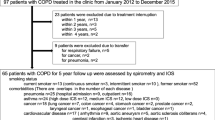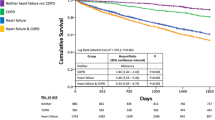Abstract
Objective
Chronic obstructive pulmonary disease (COPD) is a highly prevalent syndrome, deeply affecting the cardiovascular system as well as the lungs. We investigated the prognostic role of the QT interval and QT dispersion (QTD) in predicting all-cause, respiratory and cardiovascular mortality in COPD, and the relationship between these electrocardiographic parameters and pulmonary function in a prospective longitudinal study.
Methods
We studied 246 COPD patients without significant comorbidities, with a mild to moderate functional impairment, admitted to the Department of Internal Medicine from January 1995 to December 2001, performing a 5-year mean follow-up (5–116 months) up to August 2004. After clinical stabilisation, an electrocardiogram and functional respiratory tests were obtained, allowing measurement of the QT interval and QTD, forced vital capacity (FVC), forced expiratory volume at 1 s (FEV1), inspiratory capacity, FEV1/FVC ratio, partial oxygen pressure and partial carbon dioxide pressure in arterial blood.
Results
At the end of the follow-up period, 81 patients were dead, 165 still alive; 36 died because of respiratory causes, 23 because of cardio-cerebrovascular events, 21 because of cancer (mainly lung cancer). A significant high incidence of sudden cardiac death was observed. QTD and QTcD showed a significant relationship with respiratory functional parameters. Maximal QT interval, QTcD and QTD appear to be independent predictors of all-cause, cardiovascular and respiratory mortality (relative risk 1.94, 3.22, 2.88, respectively). Age>65 years, partial oxygen pressure <60 mmHg and inspiratory capacity <80% of the predicted value were the only other independent predictive parameters.
Conclusions
Maximal QT interval, QTD and QTcD are independent predictors of mortality. A significant incidence of cardiac sudden death was observed. These findings suggest the need for a global and multidisciplinary risk assessment in COPD patients. Intriguing relationships between the QTD and functional respiratory parameters were also observed.
Similar content being viewed by others
References
Murray CJ, Lopez AD. Alternative projections of mortality and disability by cause 1990–2020: Global Burden Disease Study.Lancet 1997;349: 1498–504.
Van den Berg P, Pinsky M. Systems approach to heart-lung interactions.Neth J Med 2000;57: 113–31.
Scalvini S, Porta R, Zanelli E, et al. Effect of oxygen on autonomic nervous system dysfunction in patients with chronic obstructive pulmonary disease.Eur Respir J 1999;13: 119–24.
Stewart AG, Waterhouse JC, Howard P. Cardiovascular autonomic nerve function in patients with hypoxaemic chronic obstructive pulmonary disease.Eur Respir J 1991;4: 1207–14.
Bartels MN, Gonzalez JM, Kim W, De Meersman RE. Oxygen supplementation and cardiac-autonomic modulation in COPD.Chest 2000;118: 691–6.
Volterrani M, Scalvini S, Mazzuero G, et al. Decreased heart rate variability in patients with chronic obstructive pulmonary disease.Chest 1994;106: 1432–7.
Stewart AG, Waterhouse JC, Howard P. The QTc interval, autonomic neuropathy and mortality in hypoxaemic COPD.Respir Med 1995;89: 79–84.
Zabel M, Portnoy S, Franz MR. Comparison of ECG variables of dispersion of ventricular repolarization: an isolated heart validation study.J Am Coll Cardiol 1995; 25: 746–52.
Zabel M, Lichtlen PR, Haverich A, Franz MR. Comparison of ECG variables of dispersion of ventricular repolarization with direct myocardial repolarization measurements in the human heart.J Cardiovasc Electrophysiol 1998;9: 1279–84.
Zareba W, Moss AJ, le Cessie S. Dispersion of ventricular repolarization and arrhythmic cardiac death in coronary artery disease.Am J Cardiol 1994;74: 550–3.
Naas AA, Davidson NC, Thompson C, et al. QT and QTc dispersion are accurate predictors of cardiac death in newly diagnosed non-insulin-dependent diabetes: cohort study.BMJ 1998;316: 745–6.
Rossing P, Breum L, Major-Pedersen A, et al. Prolonged QTc interval predicts mortality in patients with type 1 diabetes mellitus.Diabet Med 2001;18: 199–205.
Christensen PK, Gall M, Pedersen A, et al. QTc interval length and QT dispersion as predictors of mortality in patients with non-insulin-dependent diabetes.Scand J Clin Lab Invest 2000;60: 323–32.
Fu GS, Meissner A, Simon R. Repolarization dispersion and sudden cardiac death in patients with impaired left ventricular function.Eur Heart J 1997;18: 281–9.
Galinier M, Vialette JC, Fourcade J, et al. QT interval dispersion as a predictor of arrhythmic events in congestive heart failure. Importance of aetiology.Eur Heart J 1998;19: 1054–62.
De Bruyne MC, Hoes AW, Kors JA, Hofman A, van Bemmel JH, Grobbee DE. QTc dispersion predicts cardiac mortality in the elderly. The Rotterdam study.Circulation 1998;97: 467–72.
Elming H, Holm E, Jun L, et al. The prognostic value of the QT interval and QT interval dispersion in all-cause and cardiac mortality and morbidity in a population of Danish citizens.Eur Heart J 1998;19: 1391–400.
Perkiömäki JS, Sourander LB, Levomäki L, Raiha IJ, Puukka P, Huikuri HV. QT dispersion and mortality in the elderly.Ann Noninvasive Electrocardiol 2001;6: 183–92.
Okin PM, Devereux RB, Howard BV, Fabsitz RR, Lee ET, Welty TK. Assessment of QT interval and QT dispersion for prediction of all-cause and cardiovascular mortality in American Indians. The Strong Heart Study.Circulation 2000;101: 61–6.
Kiely DG, Cargill RI, Lipworth BJ. Effects of hypercapnia on hemodynamic, inotropic, lusitropic, and electrophysiologic indices in humans.Chest 1996;109: 1215–21.
Sarubbi B, Esposito V, Ducceschi V, et al. Effect of blood gas derangement on QTc dispersion in severe chronic obstructive pulmonary disease: evidence of an electropathy?Int J Cardiol 1997;58: 287–92.
American Thoracic Society. Lung function testing; selection of reference values and interpretative strategies: American Thoracic Society Statement.Am Rev Respir Dis 1991; 144: 1202–18.
Bazett HC. An analysis of the time relations of electrocardiograms.Heart 1920;7: 353–70.
Heindle S, Lehnert M, Críee CP, Hasenfusse G, Andreas S. Marked sympathetic activation in patients with chronic respiratory failure.Am J Respir Crit Care Med 2001;164: 597–601.
Abildskov JA. Neural mechanisms involved in the regulation of ventricular repolarization.Eur Heart J 1985;6 (Suppl D): 31–9.
Surawicz B, Surawicz B. Electrophysiologic basis of ECG and cardiac arrhythmias. Malvern, PA: William and Wilkins, 1995.
Lee KW, Okin PM, Kligfield P, Stein KM, Lerman BB. Precordial QT dispersion and inducible ventricular tachycardia.Am Heart J 1997;134: 1005–13.
Incalzi R A Pistelli R, Fuso L, Cocchi A, Bonetti MG, Giordano A. Cardiac arrhythmias and left ventricular function in respiratory failure from chronic obstructive pulmonary disease.Chest 1990;97: 1092–7.
Rana B, Band M, Ogston S, Morris A, Pringle S, Struthers AD. Relation of QT interval dispersion to the number of different cardiac abnormalities in diabetes mellitus.Am J Cardiol 2002;90: 483–7.
Aronow WS, Ahn C, Mercando AD, Epstein S, Kronzon I. Prevalence of and association between silent myocardial ischemia and new coronary events in older men and women with and without cardiovascular disease.J Am Geriatr Soc 2002;50: 1075–8.
Ben-Haim SA, Amar R, Shofty R, Merin G, Dinnar U. The effect of positive end expiratory-pressure on the coronary blood flow.Cardiology 1989;76: 193–200.
Pagani M, Lucini D, Pizzinelli P, et al. Effects of aging and of chronic obstructive pulmonary disease on RR interval variability.J Auton Nerv Syst 1996;59: 125–32.
Author information
Authors and Affiliations
Corresponding author
Rights and permissions
About this article
Cite this article
Zulli, R., Donati, P., Nicosia, F. et al. Increased QT dispersion: a negative prognostic finding in chronic obstructive pulmonary disease. Int Emergency Med 1, 279–286 (2006). https://doi.org/10.1007/BF02934761
Received:
Revised:
Accepted:
Issue Date:
DOI: https://doi.org/10.1007/BF02934761




